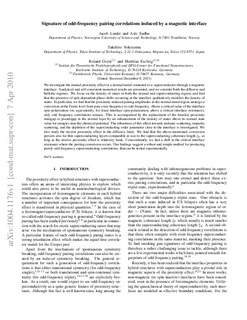| dc.contributor.author | Linder, Jacob | |
| dc.contributor.author | Sudbø, Asle | |
| dc.contributor.author | Yokoyama, Takehito | |
| dc.contributor.author | Grein, Roland | |
| dc.contributor.author | Eschrig, Matthias | |
| dc.date.accessioned | 2017-09-18T07:16:58Z | |
| dc.date.available | 2017-09-18T07:16:58Z | |
| dc.date.created | 2010-06-04T07:00:01Z | |
| dc.date.issued | 2010 | |
| dc.identifier.citation | Physical Review B. Condensed Matter and Materials Physics. 2010, 81 (21), . | nb_NO |
| dc.identifier.issn | 1098-0121 | |
| dc.identifier.uri | http://hdl.handle.net/11250/2455006 | |
| dc.description.abstract | We investigate the mutual proximity effect in a normal metal contacted to a superconductor through a magnetic interface. Analytical and self-consistent numerical results are presented, and we consider both the diffusive and ballistic regimes. We focus on the density of states in both the normal and superconducting region, and find that the presence of spin-dependent phase shifts occurring at the interface qualitatively modifies the density of states. In particular, we find that the proximity-induced pairing amplitudes in the normal metal region undergo a conversion at the Fermi level from pure even frequency to odd frequency. Above a critical value of the interface spin polarization (or, equivalently, for fixed interface spin polarization, above a critical interface resistance), only odd frequency correlations remain. This is accompanied by the replacement of the familiar proximity minigap or pseudogap in the normal layer by an enhancement of the density of states above its normal state value for energies near the chemical potential. The robustness of this effect toward inelastic scattering, impurity scattering, and the depletion of the superconducting order parameter close to the interface is investigated. We also study the inverse proximity effect in the diffusive limit. We find that the above-mentioned conversion persists also for thin superconducting layers comparable in size to the superconducting coherence length ξS, as long as the inverse proximity effect is relatively weak. Concomitantly, we find a shift in the critical interface resistance where the pairing conversion occurs. Our findings suggest a robust and simple method for producing purely odd-frequency superconducting correlations, which can be tested experimentally. | nb_NO |
| dc.language.iso | eng | nb_NO |
| dc.publisher | American Physical Society | nb_NO |
| dc.title | Signature of odd-frequency pairing correlations induced by a magnetic interface | nb_NO |
| dc.type | Journal article | nb_NO |
| dc.type | Peer reviewed | nb_NO |
| dc.description.version | acceptedVersion | nb_NO |
| dc.source.pagenumber | 13 | nb_NO |
| dc.source.volume | 81 | nb_NO |
| dc.source.journal | Physical Review B. Condensed Matter and Materials Physics | nb_NO |
| dc.source.issue | 21 | nb_NO |
| dc.identifier.doi | 10.1103/PhysRevB.81.214504 | |
| dc.identifier.cristin | 340336 | |
| dc.description.localcode | This is the authors' accepted and refereed manuscript to the article. | nb_NO |
| cristin.unitcode | 194,66,20,0 | |
| cristin.unitname | Institutt for fysikk | |
| cristin.ispublished | true | |
| cristin.fulltext | postprint | |
| cristin.qualitycode | 2 | |
